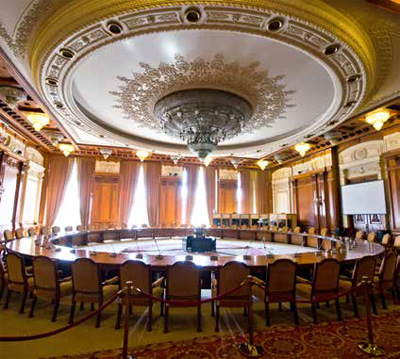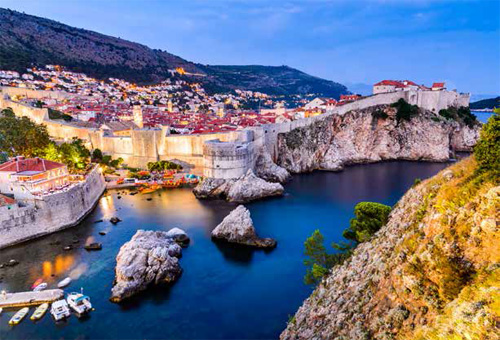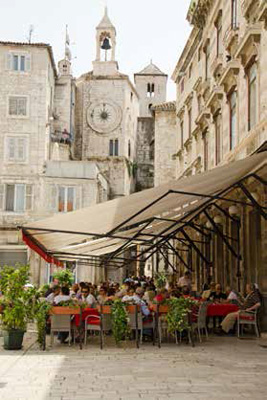Pockets of Romania’s capital city harbor half-shadows from the difficult days of Communist rule and a tumultuous past of debilitating earthquakes and riots. As Bucharest recovers from its temporary unrest and its buildings and history rise from the ashes, the city and its people carry on with unfaltering aplomb. The once-struggling city in Eastern Europe has grown to become the heart of Romania’s industrial and financial sectors. Once considered “Little Paris,” Bucharest’s homage to its pre-war past encourages an era of re-emergence in Europe’s cultural repertoire.
Periodic pauses from offices and conference halls lure visitors to Piaţa Universităţii (University Square), where in 1990 students gathered in a peaceful-turned-violent, anti-Communism protest. Today the National Theatre and Sutu Palace call the bustling square their home. A short walk from the square’s InterContinental hotel, which towers in the distance, sits the uniquely designed and colorful St. George’s Church, a stunning display of artwork and architecture within the walls of an unassuming edifice.
Slightly south of Piaţa Universităţii lies Bucharest’s Old Town, also known as Lipscani. Following a serious and fairly recent transformation, this neighborhood is considered one of the world’s youngest old towns. Meander through the cobblestone streets before dipping into Pura Vida Sky Bar for an end-of-day cocktail at Lipscani’s only rooftop bar.

Interior of the Parliament building in Bucharest, Romania © CCAT82 | DREAMSTIME.COM
There is simply no way to avoid the behemoth that is Bucharest’s Parliament building. The world’s second-largest administrative building (only after the U.S. Pentagon) resides a few blocks southwest of Old Town. Construction began in 1984 and continues to this day. Purchase entry tickets in advance, as the only way to peruse the interior’s 3,100 rooms is with an official guide.
For a real respite from long days trapped indoors at meetings and seminars, head outside to Herăstrău Park. Situated north of Bucharest’s center, the massive space comprises large lakes, a Japanese garden and expansive green fields that take you miles away from the chaotic Romanian capital. Dine at one of the restaurants or check with the tourism office for performance schedules at the open-air theater.
Approximately 3.5 hours southwest of Bucharest rests a discrete paradise where fantasy evolved from a volatile past and where harmony now echoes from the valley of towns nestled between the mountains and the Adriatic Sea. Stretching from the bustling resort town of Split to the well-preserved medieval city of Dubrovnik in the south, Croatia’s Dalmatian Coast is littered with islands just as captivating as the coast itself.

Old Town of Dubrovnik as viewed from Lovrijenac Fortress © EMICRISTEA | DREAMSTIME.COM
Split, the central point of the Dalmatian Coast, possesses all the expected qualities of a coastal city: stalls selling postcards and sachets of lavender, a harbor full of yachts and sailboats, and visitors wandering along the promenade in sun hats and flip-flops.
At night, the promenade and streets of the Old Town come alive as traditional Croatian music wafts through the outdoor bars and restaurants. Just before sunset, climb the sequence of stairs to Marjan Park and enjoy a cool glass of Croatian wine at the hilltop Vidilica Café along with views of the city, seaport and mountains in the distance.
Staying on land while visiting the Dalmatian Coast would be an immense disservice to the 79 islands that dot the striking Adriatic Sea. When it’s too difficult to choose from the islands, commit to visiting the following two by boat.
Hvar is a slender strip of an island located just off the coast of Split. Known to be a favorite of both Prince Harry and Beyoncé (the latter named her first-born child after an indigenous blue ivy that grows on the island), Hvar’s Old Town is not as posh as one might surmise. Open plazas serve as the central organ to which the veins of the winding alleys flow.
Hvar Island earned the nickname Lavender Island because its dry, warm climate lends itself to the cultivation of the aromatic plant. On the island of Hvar, it is difficult to avoid the flower in almost any buyable form, from lavender gelato to lavender oil. Uses of the oil range from a sleep-inducing aid to a mosquito repellant, and all its varieties are sold in shacks along the water’s edge.
Above the hill of Hvar Town stands the towering fortress with views that stretch over the harbor. Yachts of the rich and famous pull up with their guests who seek a warm escape from the more populated coastal towns.

A café in Split, Croatia © ABSENTE | DREAMSTIME.COM
A tour of Split’s sister islands continues to the neighboring Brač (rhymes with “watch”), the largest island among the Split-centric cluster. The abundance of limestone and dolomite contributed to the construction of buildings throughout the region since the days of Roman rule.
Brač cuisine specializes in using every part of milk-fed lamb in a dish called vitalac. The lamb’s entrails are roasted on skewers, rubbed with grass and finished off with a few splashes of wine or Prosecco.
Scenic bus routes from Split to southern parts of Croatia include two options for the 150-mile journey. Whether traveling along the coast and past hillside towns or through the countryside with periodic intra-mountain tunnels, the terrain and views are nothing short of spectacular.
From above and beyond the sea, Dubrovnik resembles a mythical land where fairy tales are born and history lives eternally. After a few steps into the walled city, visitors are transported to the days of pirate ships, sky-kissing castles and medieval rule. With origins that date to the seventh century, Dubrovnik transitioned through time as one of the most well-preserved UNESCO World Heritage sites.
A sea of coral- and salmon-colored rooftops gleams underneath the coastal sunshine as boats dock ashore and deliver fresh catches of the day. The cradle of Croatian cuisine rests along the shores of Dubrovnik, a view one can capture from many a seaside restaurant. Just outside the walls of the Old City sits Dubravka, an upscale café serving fresh dishes with a romantic dash complemented by the patio views that peer through two medieval towers and out to the sea.
Athletic travelers looking for an invigorating climb with rewarding views can hike 90 minutes up to the top of Mount Srđ. Alternatively, a cable car transports passengers from Dubrovnik to the top of the mountain for approximately $9. Once atop the 1,350-foot mountain, the entire city presents itself, and it suddenly becomes clear just how easily Dubrovnik became a fishing and trading port for the entire Adriatic Sea. The Srđ Imperial Fort also rests at the top of the hill, a monument that played a critical role in Croatia’s history. Within the Museum of Croatian War of Independence visitors can learn more about the fort’s use since its construction during the Napoleonic Wars until as recently as the 1990s.
Back down at sea level, make a point to seek out the clandestine Café Buza, a bar that practically hangs from the cliffs outside the walled city. Just after sunset, Dubrovnik’s Old Town erupts with activity as street musicians perform for lovebirds nursing pitchers of Croatian wine.
Romania and Croatia may appear as polar opposites in terms of landscape, climate and general ambience, but together the two nations within the eclectic region of Eastern Europe bear personalities and histories which unearth a new world of possibilities.
Info to Go
Henri Coandă International Airport (also known as Otopeni Airport) lies approximately 10 miles north of Bucharest. Bus 783 travels to the center of the city every 15 minutes on weekdays and every 30 minutes on weekends. The 45- to 60-minute ride costs about $1.75. For $2 take the train, departing hourly from the airport, 35 minutes to Gara de Nord. A taxi from the airport costs approximately $17.50.
Split (Resnik) Airport, 15 miles northwest of the city, offers two bus options to Split with a ride time of 40 minutes: Bus 37 ($3) and the Pleso Prijevoz airport bus service ($4.45).
From Dubrovnik Airport, Atlas Croatia travel agency offers bus service to Dubrovnik’s Old City and the main bus station (approximately 30 minutes). Tickets cost $6 one way and $10 roundtrip. Departure times vary by day; check the Atlas website.
Bus travel between Split and Dubrovnik takes four to five hours, depending on the route and bus service. GetByBus offers competitive fares from various bus lines with multiple departures each day. Purchase tickets in advance or at the main bus terminals in each city.
Read This Next

Introducing
FX Excursions
FX Excursions offers the chance for once-in-a-lifetime experiences in destinations around the world.
#globility
Insta FeedDaily
Apr 19, 2024Rosewood São Paulo Now Home to Asaya Spa by Guerlain
Nestled within the sustainable Rosewood São Paulo, Asaya Spa by Guerlain offers a first-of-its-kind urban retreat. Designed by legendary Philippe Starck, the wellness destination delivers a creative opportunity for guests to achieve personal transformation while enjoying a luxurious getaway.
Sponsored Content
Fill Your Heart with Ireland
Whether it's the people, the craic (fun) or the coasts, travelers always find something to love about the island of Ireland. What fills your heart?
Daily
Apr 19, 2024The Iconic Bayeux Tapestry in France to Get New Home
Under the direction of the Town of Bayeux, France, in close collaboration with the French government, the Normandy Region and the Department of Calvados, the project to move the famous 11th-century Bayeux Tapestry to a new space has been approved.
Daily
Apr 19, 2024Turtle Bay Resort Partners with Salesforce
Turtle Bay Resort and Salesforce recently announced a partnership. Salesforce will help the O’ahu-based resort augment service agents with AI and personalize the entire guest experience. Salesforce’s Einstein 1 Platform will help the resort with its efforts to reinvent itself, heighten awareness of its offerings and establish new customer relationships.
Sponsored Content
Why Buy Trip Cancellation Insurance?
Don’t risk losing all the money you’ve spent if you must cancel your trip at the last minute. Allianz Travel Insurance can give you:
Daily
Apr 18, 2024Fort George Hotel & Spa Transforms Belize City from Gateway to Destination
Belize City is better known as a business center and a stop en route to Belize’s lush rural destinations, but Fort George Hotel & Spa promises to change things up and reframe the nation’s capital as a destination in its own right. Located in the city’s Fort George neighborhood, the hotel debuted as the first luxury hotel in Belize City, boasting sophisticated design, elevated culinary offerings, expansive guestrooms and an inspiring wellness program. The hotel also features a branded fitness center, plunge pool and K’IN Spa.
Amansara Review
eFlyer Reviews
Apr 17, 2024Regent Santa Monica Beach to Debut This Summer
Daily
Apr 17, 2024eFlyer News
Apr 17, 2024Swiss International Air Lines Begins New Service from Washington, D.C., to Zürich
Swiss International Air Lines recently launched daily flights from Washington, D.C. (IAD), to Zürich (ZRH). The daily flight is one of three new international routes SWISS launches this summer season, with Toronto (YYZ) and Seoul (ICN) slated in the coming months.
Sponsored Content
Why Buy Annual Travel Insurance?
One affordable plan can protect an entire year of trips: business or pleasure, short or long, domestic or international.
eFlyer Deals
Apr 17, 2024Choose Your Coastal Adventure at The Ryder Hotel in Charleston
Experience Charleston, South Carolina, like never before during a stay at The Ryder Hotel. This charming property launched the Choose Your Coastal Adventure offer to take guests to the waters to see the city from a new perspective.
ShareThis